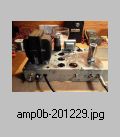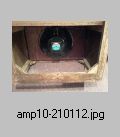Winter 2020
Late 50's, early 60's Fender Tweed Champ Amp (Clone)








========================================================================
The idea:
Convert a 1947 Philco console radio into a guitar amplifier. The amp shall
be based upon the Fender Tweed Champ, late 50's-early 60's, 5F1 schematic.
The amp shall utilize as many parts as possible from the original radio.
The beginning:
I wish to especially thank the youtube channels "Uncle Doug" and "D-lab Electronics"
for the inspiration and the priceless information that they convey to everyone
free of charge and free of advertising. I encourage anyone that gets
anything at all from these channel to throw a few schekels their way.
The warning:
I wish to encourage anyone who does any kind of work inside the chassis of a tube
amplifier and is as deathly afraid of high voltage as I am, to watch, understand,
and heed the safety videos that "Uncle Doug" has uploaded. Things like isolation
transformer, adjustable voltage controller (variac), current limiter, capacitor
discharger, insulated work surface, insulated floor surface, the "one hand in pocket"
rule, and never put ones hands in a chassis under power to name only a few.
You have been warned...

The console radio:
1947 Philco console radio model 48-1264 (which was purchased for $20 and was
non-functional) from which the enclosure, chassis, power transformer part# 32-8248,
two Cinch 8 pin tube sockets, a 6V6GT tube, and several terminal strips were salvaged.



The schematic:
schematic
The bill of material (BOM):
bom
The parts:
My "junk box" was pretty empty of tube related and high voltage parts so I had to order many
new parts from "Antique Electronic Supply" (www.tubesandmore.com) and various ebay sellers.
I had intended to browse hamfest flea markets but the covid problem of 2020 precluded that.
This of course ran my cost somewhat over budget but what else can one do in these conditions.
I was able to attend the Traverse City hamfest in February 2020 and pickup a few things like
a Variac and some test equipment.
The Status:
12/31/20. The amp is up and running using an 8 ohm, 50 watt, 3.5 inch bookshelf speaker.
I am amazed to hear the sounds put out at about 4 on the volume control. A clean and edgy sound with
just some breakup and distortion at times just like one would expect. I have a Jensen 12 inch
vintage Alnico P12R on its way and I can't wait to hear how the amp sounds through that. Also
I will add a pilot light. Finally, I will install the new speaker and the amp into the original
Philco radio console cabinet. I have worked on the cabinet some, adding a shelf where the phonograph
used to be which will "kind of" box in the speaker and provide a place to store guitar cords, accessories,
pedals and the like. Also, I'm working on adding some blue LED's which will shine through the tuning
dial in the front of the cabinet just for a laugh. I stole that idea from Terry at D-lab Electronics.
I plan to do a video demonstration of the amp in the coming weeks and either host that here or on
Youtube.
01/10/21. Philco radio console cabinet refurbished to some degree. Loose veneer was glued back down. Cabinet
latches installed on the (former) phonograph door. Jensen speaker installed. Pilot light lampholder and red
jewel installed. A light bulb did not come with the lampholder, so some are on order. The amp chassis was
installed and the amp given a sound check. I really don't know what it should sound like, but it sounds pretty
to good to me, and similar to the sounds I hear on various Fender Champ demonstration videos. A bug was discovered.
When the volume control was at 8 or above a snap, crackle, and pop sound was heard and then the amp squealed and
buzzed pretty bad. Two things were changed. The B+ voltage was reduced to 330 volts and the cathode bias resistor
(and a capacitor that I added) on the first triod of the pre-amp tube was removed and replaced with a new resistor
only (no capacitor). Problem solved. Now the amp will go to full volume. The speaker is breaking up at that point
so I don't know how useful the amp would be at full volume, unless that is the sound one is looking for. I would
wonder how long the speaker would last under those conditions.
01/11/21. I'm now working on reconfiguring my workbench/computer workstation and installing some equipment that I hope will
enable me to learn how to record either a video or sound recording of the amp.
01/12/21. Light bulb arrived and installed. Amp is amping.




01/17/21. The 6V6 output tube was rebiased. The result:
B+ 345 volts
Rcb 560 ohm
Vcb 17.7 volts
Icb (17.7/560) 31.6 mA
PD 345(.0316) 10.9 watts
1/18/21. The distortion bug came back with a vengence. Any volume greater than about 80%
would cause the amp to stop amping and throw itself into distortion of some type. As I said
before, it makes an unpleasant buzzing sound. I had been changing B+ voltage and 6V6 tube bias
which mostly got rid of it but at the cost of a "cold" bias and somewhat reduced sound output.
So, I buckled down today and tried everything I could think of to find root cause. Finally,
a simple wooden stick help me find the problem which turned out to be the cheap, Chinese, ceramic
tube socket for the 12AX7 pre-amp tube. I read a warning about these things after I had bought
some and installed one into the amp. I had a bad feeling about it when it became obvious that
it took a lot of pressure to insert the tube. Way too much. Anyway, the wooden stick test showed
that the plate (pin 6) of the second triode made intermittent contact. Replacement was called
for and I had some Micalex sockets that I had bought after I found out about the problems with
the ceramic sockets. I pulled everything connected to the socket off and got that thing out of
there. Installed the Micalex and reconnected everything. Cut back on the B+ to 325 volts.
Installed a 470 ohm cathode bias resistor on the 6V6. NOW the amp will go to full volume with
no problems. Lesson learned.
Biased the 6V6 once again. The result:
B+ 325 volts
Rcb 470 ohm
Vcb 16 volts
Icb (16/470) 34.0 mA
PD 325(.034) 11.1 watts
Now we're talking.















 01/17/21. The 6V6 output tube was rebiased. The result:
01/17/21. The 6V6 output tube was rebiased. The result: